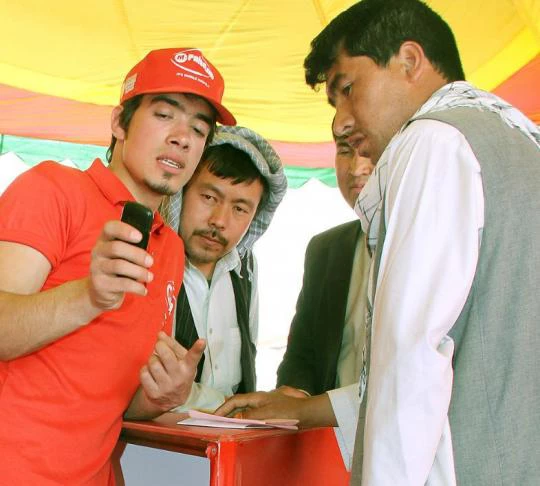With as many as 12 million mobile phone users, mobile is booming in Afghanistan (Credit: USAID, Flickr Creative Commons)
Afghanistan has made significant progress in its development since 2001. Yet, these achievements remain fragile due to a volatile security situation and limited human capacity. Of an estimated 30 million inhabitants, 46 percent is under the age of 15 and with high population growth, the country is experiencing a classic youth bulge. In addition, literacy rates remain at extremely low levels (approximately 43% for men and 12% for women).
In spite of these constraints, the ICT sector in the country has witnessed remarkable growth, with as many as 12 million mobile phone users. Four private mobile companies and one state-owned company operate in the country; private investments in telecommunications now exceed US$1.6 billion. A recent survey conducted by USAID noted that around 80 percent of women in the country have regular or occasional access to a mobile phone.
The Government is also adopting ICT to expand service delivery and support good governance, and private firms have been quick to adopt advanced technologies. In 2011, the GSMA presented the Afghan Minister of Communications and IT with the mobile industry’s prestigious annual Government Leadership award, recognizing the monumental achievements made by the government in promoting and expanding mobile communications. And rightly so; the investment in this sector has potential for high returns, providing employment and accounting for government revenue and foreign investment. Afghanistan is by all accounts a promising territory to spur a flourishing mobile app economy.
infoDev recently launched a feasibility study to gauge the mobile applications sector in Afghanistan. The study aims to map and understand the current business environment for SMEs in the ICT sector and assess the overall ecosystem for business incubation, measure the opportunity to create and support a vibrant mobile applications incubator and provide recommendations on the way forward for implementation.
And what are the models of implementation? Drawing on experience from infoDev’s mobile entrepreneurship projects and activities in other countries, particularly mLabs, mHubs and virtual incubator projects, the study will aim to build and expand the development of a mobile applications sector targeting the needs of the country. All of this will be achieved by building local capacity to deliver relevant training and education to applications developers and entrepreneurs.
Initial findings from the study reveal a promising terrain to stimulate the mobile app economy. We’ve assessed the technical environment, major ICT players in the country, the regulatory environment, level of human capital, enablers for business skills and finance. And the right ecosystem seems to be in place; for example the existence of a dynamic mobile industry, increasingly affordable internet access, a pioneering landscape for mobile innovation and entrepreneurship and a strong commitment from donors and the government of Afghanistan. In addition, pressing social issues provide a window of opportunity for creative solutions to be provided through tech-oriented initiatives.
We estimate that the mobile app market will grow from its estimated US$ 20 – 33 million to US$ 48-60 million, at least twice the current size in the next three years. The main gross potential, be it mobile content or software providers, is applicable to SMEs. Our estimates are based on a number of key assumptions; an increase in connected users with internet access, increased smartphone penetration, the establishment of a government platform for delivery of applications (HOSA) and the availability of catalysts such as DEWAE, an innovation support grants scheme providing US$ 5million in support to boost the apps economy.
What model will work in Afghanistan, a mobile applications Lab (mLab), mobile applications Hub (mHub), virtual incubator or a combination of the three? We think increased awareness, relevant skills and access to practical experience in the mobile industry are a top priority. In addition developers need more access to tools that are localized. And finally an alternative application distribution mechanism, enabling access to a greater market and capacity to bill services is essential.
In other countries where we have implemented similar initiatives, youth and women have been the main beneficiaries of the various training programs. And while it has been said over and over, mobile phones really do provide a way for marginalized groups and low income populations to access information and benefit from social and economic services. Case in point, Roya Mahboob, is an Afghan woman entrepreneur from Herat, who took an innovative idea and made it into a successful tech company. This year she was named to the 2013 Time 100 list, an annual list of the world’s most influential people.
Take a look at our initial findings and weigh in with your thoughts by commenting below or writing to Anushka Thewarapperuma.



Join the Conversation